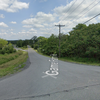Heldeberg Workshop gets $8K grant to study human history of its land
— Photo from the Heldeberg Workshop
The pre-1767 Jacob Cooper house — its foundation explored here by workshop students in 1995 — is one of the oldest houses built by European settlers below the Helderberg escarpment, according to the Heldeberg Workshop, which says it was also the site of a Tory robbery in 1779 and a subsequent visit to the property by the Commission for Detecting and Defeating Conspiracies.
NEW SCOTLAND — For more than half a century, kids have learned at the Heldeberg Workshop by exploring the workshop’s land beneath the escarpment.
Now, the workshop has been awarded a grant that will let it study and report on the history of that land.
The Heldeberg Workshop was awarded an $8,000 grant by the Preservation League of New York State to fund a Historic Landscape Report of the property from 1750 till now, it announced in a release.
The 237 acres that make up the workshop property include 20 miles of hiking trails, a pond, a wetland, a waterfall, meadows, and the slope of the escarpment, providing access to diverse ecological and geological sources.
That property is part of the Helderberg Conservation Corridor, protected through the Mohawk Hudson Land Conservancy.
The workshop’s land is part of a 3,700-acre corridor, stretching from the Black Creek Marsh to John Boyd Thacher State Park. After a decade of fund-raising and grant-seeking, the land conservancy a year ago paid the Heldeberg Workshop $200,000 to secure the easement
While the focus with the easement to prevent development had been on ecological preservation, the current funding is to look at the human history of the land.
The yet-to-be written landscape report is to “shed light on the history of life beneath the Helderberg escarpment,” said Dorothy Matthews, who chairs the workshop’s development committee, in the release. “That knowledge will enrich our classes and generate interest among amateur and professional historians and archaeologists.”
The workshop property contains foundations of a pre-1767 homestead and a possible barn, a well, remains of an abandoned road, and a cemetery from the middle of the 19th Century.
A rebel Tory attack occurred at the homestead in 1779. This resulted in a visit to the property by patriot commissioners for Detecting and Defeating Conspiracies, a legal body formed in Albany in 1779 for the purpose of ferreting out traitors to the American cause.
The land is also the site of a farm owned by Captain Henry Crounse, a Civil War Army officer.
The Heldeberg Workshop was one of 22 applicants in 18 counties to receive support totaling $235,920.
Founded in 1961, the workshop is known for its summer programs. Over a six-week period, 1,200 Capital Region students participate in more than 100 non-traditional classes such as fossil hunting, blacksmithing, and weaving, taught by professional instructors, artisans, and experts.
Learning takes place in 32 lean-tos, a large multi-unit pavilion, a theater building and outdoor stage, a working blacksmith shop, an archery building, a puppet stage, a half-size Iroquois-inspired longhouse, and a tepee.
Located at 353 Picard Road in New Scotland, the Heldeberg Workshop also offers weekend classes to children, adults, and families in the fall and spring months, and supports the use of the property by area scouting and 4-H groups, environmental and historical organizations, college classes and students working on independent research projects.
A sugar shack is currently being built, which will be used to demonstrate how maple syrup is made using the workshop’s own sugar maple trees.
“The Preserve New York program ensures arts and culture organizations continue to be beacons of New York’s rich history,” said Mara Manus in the release. She directs the New York State Council on the Arts, which partners with the Preservation League in awarding the grants. “By preserving significant spaces and sites, we promote vitality and drive economic activity across our great state.”



